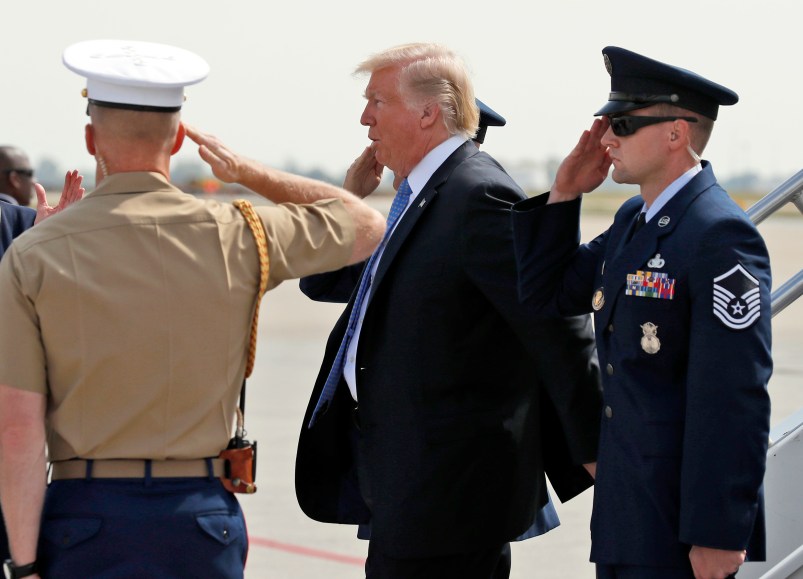WASHINGTON (AP) — The Trump administration defended its decision Wednesday to sharply curtail the number of refugees allowed into the United States to 45,000 next year, even as global humanitarian groups decried the move and called the number far too low.
The 45,000 cap, to be formally announced by President Donald Trump in the coming days, reflects the maximum the U.S. will admit during the fiscal year that starts Sunday, although the actual number allowed could be far lower. Even if the cap is ultimately hit, it would reflect the lowest admissions level for the U.S. in more than a decade.
Lowering the cap reflects Trump’s opposition to accepting refugees and other immigrants into the U.S., an approach that has already driven down refugee admissions. Former President Barack Obama had wanted to take in 110,000 in 2017, but the pace slowed dramatically after Trump took office and issued an executive order addressing refugees. The total admitted in the fiscal year that ends Sunday is expected to be around 54,000, officials said. In 2016, the last full year of Obama’s administration, the U.S. welcomed 84,995 refugees.
Though a broad array of criteria determines who receives refugee status, the allotments are broken down into specific numbers of refugees admitted from various geographic regions. The State Department conveyed those numbers to Congress on Wednesday, officials said.
Africa will receive the largest allotment of 19,000 refugees, or 42 percent of the total. The next-highest number goes to the Middle East and South Asia, which will be granted 17,500 slots, or 39 percent. The remaining allotments include 5,000 for East Asia, 2,000 for Europe and 1,500 for Latin America and the Caribbean.
Although the totals are far lower than in the Obama administration, the percentage granted to each region was left almost unchanged from the last year of Obama’s term. One key difference: there will no longer be an “unallocated” allotment of 14,000 refugees that could come from any region.
Trump’s decision has drawn consternation from aid groups who have pointed to refugee crises that have worsened, not improved, including in Syria, Myanmar and South Sudan. Several groups have urged Trump to reconsider and adopt a figure closer to Obama’s goal of 110,000.
“With historically high numbers of innocent people fleeing violence worldwide, the United States response cannot be to welcome a historically low number of refugees into our country,” said Bill O’Keefe of Catholic Relief Services.
But Trump administration officials said the new cap will advance national security interests and reflect the United States’ capacity to properly screen and take in refugees. They said new screening and admittance requirements for refugees will be announced later, as a 6-month review, ordered by Trump near the start of his presidency, draws to a close.
It’s unclear how those requirements might affect individuals from countries included in Trump’s revised travel restrictions, a list that includes Syria, Yemen, Chad, Libya and Somalia. Officials couldn’t say whether people from those countries would be allowed in as refugees. The officials briefed reporters on a conference call on condition of anonymity.
Trump’s administration settled on the 45,000 figure after a vigorous debate among his top advisers, other officials have said, including some who advocated letting in far fewer. Strong opposition to higher levels from some top aides has fueled speculation that Trump’s administration might set a limit of 45,000, but then deliberately slow-walk admissions so that the number actually allowed in is significantly lower.
But officials pushed back, arguing that while it’s often the case that actual admissions are somewhat lower than the cap, the U.S. would work to accept as many as possible within the 45,000 limit.
Worldwide, there were some 22.5 million refugees last year, according to the U.N. High Commissioner for Refugees, with many more people internally displaced within their home countries. The strong preference among aid groups and governments has been to seek conditions so refugees can return to their homes, rather than being permanently resettled in host countries.
Trump has made limiting immigration the centerpiece of his policy agenda. He temporarily banned visitors from a handful of Muslim-majority nations, has rescinded an Obama-era executive action protecting young immigrants from deportation and insists he’ll build a wall along the southern border with Mexico.







The only way I would accept this is if we take 3.5M PR residents in.
Well you know there is Puerto Rico to consider, how many brown people will come here?
Somewhat related: Why was Chad included in the most recent iteration of the travel ban? Stephen Miller and Elaine Duke, Acting DHS Secretary, overruled concerns from the State Department and the Pentagon.